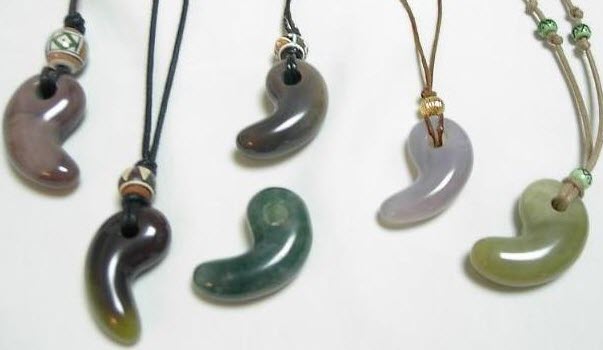The magatama is a curved, comma-shaped bead from Japan. The oldest known magatama beads are from the Final Jōmon period (circa 1000–300 BCE). During this period, the magatama beads were made from stone and earthen materials. Later, towards the end of the Kofun period, the magatama beads were made almost exclusively of jade.
Archaeological findings suggest that magatama beads were produced in certain areas of Japan and transported to other parts of the country through the trade routes.
It is generally believed that the magatama beads started out as decorative jewelry in the Final Jōmon period and then gradually became seen as religious and ceremonial objects with special powers.

Why is it shaped like this?
Archaeologists and historians have come up with various hypotheses to explain why the magatama is shaped like a comma, but no consesus has been reached and there is a distinct lack of evidence to support any of the theories.
Some researches have suggested that the earliest magatama beads were fashioned after fangs or other teeth from animals. Others have suggested that the magatama is supposed to look like the moon or like a very small fetus.
There are also those who believe that the magatama isn’t shaped to resemble anything else.
The Gogok
The Gogok is a similar bead found in at prehistoric sites throughout the Korean Peninsula. Although most of them are jade, nephrite gogoks have been discovered in burial chambers from the Bronze Age.
In art from the Three Kingdoms period, we can see gogoks in the crowns of Silla, in the royal girdle of Korea, and in various earrings and necklaces.
The Kojiki and Nihon Shoki
The Kojiki and Nihon Shoki texts both make numerous referrence to magatama. The Kojiki is the oldest extant chronicle in Japan and was composed by O no Yasumaro in 711-711 AD. The Nihon Shoki, finnished in the year 720 AD, is the second-oldest book of classical Japanese history and considerably more detailed than the Kojiki. The myths contained in these two texts have been part of the inspiration behind many traditional Japanese practices, and many of the myths were later re-appropriated for Shinto practices.
Magatama is used to create new gods
Magatama is mentioned in the very first chapter of the Nihon Shoki, which includes a story about how Susanoo – a good of sea and storms – recieves five hundred magatama from a jewel-making deity named Tamanoya no mikoto. In this story, Susanoo gave them to his sister in heaven, the sun godess Amaterasu, and she bit off parts of the magatama and blew them away to create new gods. Later, Amaterasu shut herself in a cave and Tamanoya decorated a sakaki tree with magatama and other objects in a successful bid to tempt Amaterasu to come out of the cave again.
In the Shinto relgion, Tamanoya no mikoto is the god of magatama, glasses and cameras.
The magatama in the badger
The Nihon shoki records that in the year 58, when Suinin was the reigning emperor, a dog killed a mujina badger, and when the carcass was disemboweled a magatama was found. This magatama was brought to the emperor who placed it at the Isonokami Shrine.
Early magatamas
As mentioned above, the oldest evidence of the existence of magatama are from the Final Jōmon period (circa 1000–300 BCE). The magatama that we know of from this period were made from materials such as clay, slate, gneiss, talc, nephrite, quartz, serpentinite and jadeite.
During this era, a magatama created in one region could be rather different in shape from a magatama created somewhere else. This heterogeneity is not something that’s common during later periods of Japanese history.
By the end of the Final Jōmon period, the magatama are believed to have made the transition from being purely decorative objects to become important in various ceremonies.
